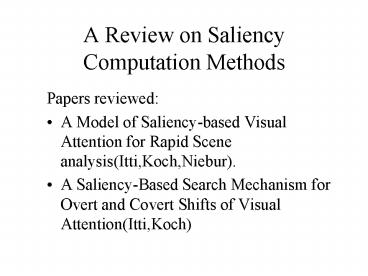A Review on Saliency Computation Methods - PowerPoint PPT Presentation
1 / 15
Title:
A Review on Saliency Computation Methods
Description:
A Model of Saliency-based Visual Attention for Rapid Scene analysis(Itti, ... involves either rapid, saccadic eye movements to bring the fovea onto the object. ... – PowerPoint PPT presentation
Number of Views:71
Avg rating:3.0/5.0
Title: A Review on Saliency Computation Methods
1
A Review on Saliency Computation Methods
- Papers reviewed
- A Model of Saliency-based Visual Attention for
Rapid Scene analysis(Itti,Koch,Niebur). - A Saliency-Based Search Mechanism for Overt and
Covert Shifts of Visual Attention(Itti,Koch)
2
Introduction
- Primates. Object identification involves either
rapid, saccadic eye movements to bring the fovea
onto the object. - Only a small part of the information registered
by the visual system at any given time reaches
levels of processing that directly influence
behaviour. - Preattentive selection gives more importance to
some image regions(salient regions)
3
Model
- Bottom-up control of attention. Localization of
the stimuli.(Where, not What) - Focus of Attention(FOA).Region which the system
is looking. - Inhibition of Return(IOR). The FOA at time t is
inhibited during constant time. Well demostrated
for covert attentional shifts in humans. - Static color images. Nine scales are created
using Gaussian pyramids(progressively low-pass
filter and subsample the image), from 11 to
1256.
4
Some definitions
- Center-surround difference. Given two scaled
images I(i),I(j), is obtained by interpolation
to the finer scale and point-by-point
subtraction. Denoted by - Across scale addition. Reduction of a map to
scale 4 and point-by-point addition. Denoted by
5
Early Visual Features
- Intensity contrast. Detected in mammals by
neurons sensitive to either dark centers-bright
surrounds, bright centers-dark surrounds.
6
Early Visual Features(2)
- Center of the receptive field, neurons
excited by one color and inhibited by another. In
human primary visual cortex are red/green,
green/red, blue/yellow, yellow/blue.
7
Early Visual Features(3)
- Orientation-selective neurons in primary visual
cortex
8
Normalization operator
- Normalize the values in the map to a fixed
range0...M. - Find the location of the maps global maximum M
and computing the average m of all its other
local maxima. - Globally multiplying the map by (M-m)2
- This factor replicates cortical lateral
inhibition mechanisms, in which neighborging
similar features inhibit each other.
9
Saliency Map(Version 1)
- The motivation of three diferent values is that
similar values compete strongly for saliency,
while different modalities contribute indepently
to the saliency map
10
Saliency Map(Version 2)
- After applying the normalization factor, this map
modification is done 10 times.
The above map modification is applied to these
three maps. Finally,
11
Version 1
Version 2
12
Comments
- In the version 1, it fails to reliably detect
pop-outs in search arrays
13
Comments(2)
- There is no top-down process.
- Does not include any measure of saliency based on
temporal stimulus onset or dissapearance or on
motion. Neither grouping of stimuli. - Very robust to the addition of noise.
- There is no any recurrent mechanism(cannot
reproduce phenomena like contour completion and
closure, important for certain types of human
pop-out).
14
Questions
- Does saliency maps involve different
behaviours/different visual-motor patterns? - If saliency is encoded across multiple maps, how
competition can act across these maps to ensure
that only a single location is chosen? - Saliency is encoded in one/many maps?
- In which way the top-down and bottom-up processes
are related? - How many features should be in mind to obtain all
relevant saliency map(s)?
15
Related papers(BMCV 2002)
- Biologically inspired saliency map model for
bottom-up visual attention.(Park, Shin, Lee) Here
there is an implementation of the saliency model
presented, but with other features(edges,
simmetry and color differences). - A goal oriented attention guidance
model.(Navalpakkam, Itti). They uses the saliency
map just presented, with a topographic
task-relevance map. Basically, the saliency map
filters the image to be used by the
task-relevance map.































